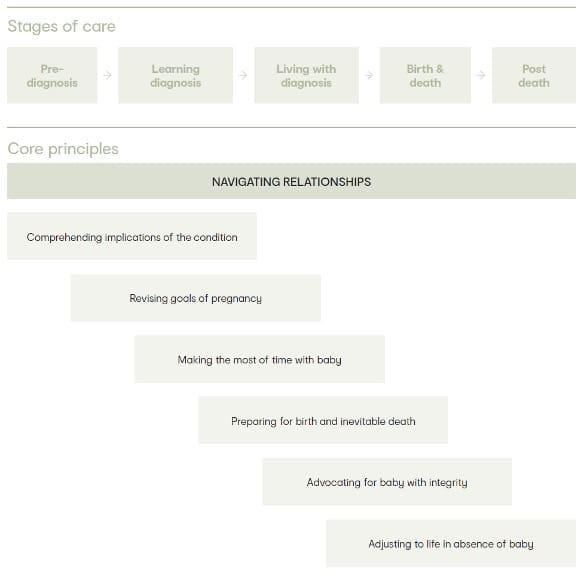The need for palliative care may be recognised during pregnancy (for example at the 20-week antenatal scan), or may not become apparent until after a baby is born.18 Healthcare professionals should discuss the option of palliative care with parents and begin care planning as soon as possible if a palliative care approach is chosen. A palliative care approach may continue for many months.
Care planning starts when you make the decision to take a palliative care approach.
Perinatal palliative care planning includes a birth care plan, palliative care plan, and perinatal loss care plan to support parents and family/whānau based on their values, preferences, and wishes and their cultural, religious, and spiritual needs.22,23 Parallel planning is a process of developing multiple plans for ongoing care alongside planning for end-of-life care.18 Parallel planning takes into account the often unpredictable course of conditions and potential outcomes and can help prepare parents and families/whānau for what may happen during pregnancy, birth and after birth.
The decision-making process of developing and implementing a care plan can help parents regain some control over their baby’s future.15
Members of the multidisciplinary team should support family/whānau as they process the diagnosis and care plan throughout the pregnancy.24 Team members need to embrace flexibility when the care plan is changing and communicate this openly to parents.25 Perinatal palliative care planning can help parents gain a sense of control over their pregnancy and define a relationship with their baby, while also serving as a communication tool for healthcare professionals.12,19
Perinatal palliative care planning should be available across the continuum of care regardless of where parents are in their pregnancy (Figure 1). The Western Australia Department of Health Perinatal Palliative Care Model of Care1 provides pathways for the referral and entry of the baby and their family/whānau into a palliative care approach. Healthcare professionals and the wider community of service providers can use the model when planning and providing perinatal palliative care. Palliative Care Australia provides a practical guide to palliative care in paediatrics to empower healthcare professionals to care for babies and children at home or as close to home as possible.
In Aotearoa New Zealand, the ‘Comfort as a Model of Care’ document co-developed by the Neonatal Nurses College Aotearoa and the New Zealand Nurses Organisation outlines a set of principles to assist neonatal nurses in providing palliative care to babies in partnership with families/whānau.2 The Paediatric Palliative Care Clinical Guidelines developed by the New Zealand Paediatric Palliative Care Clinical Network provides clinical guidelines for end-of-life care of babies, children, and young people in Aotearoa New Zealand.26 See Appendix 4A for an example of a perinatal palliative care plan.

Consensus-based recommendation 4.2
Parallel planning related to potential outcomes should be considered to provide comprehensive information to parents and family/whānau (for example antepartum stillbirth, intrapartum stillbirth, very early neonatal death, survival). Develop a detailed perinatal palliative care plan that includes all phases and transitions of care:
Evidence-based recommendation 4.3
Evidence quality: Moderate confidence
Provide perinatal palliative care within a parent-centred decision-making framework involving parents and family/whānau and the multidisciplinary care team.
Level 3, Aubigny Place
Mater Research Institute
Raymond Terrace,
South Brisbane QLD 4101
The University of Queensland Faculty of Medicine